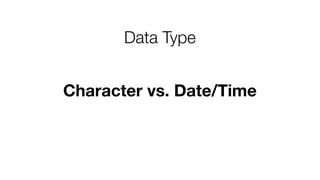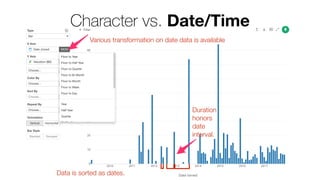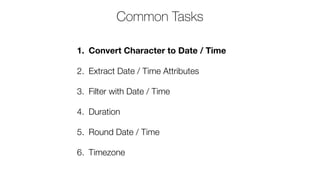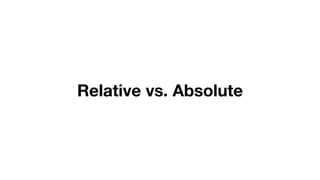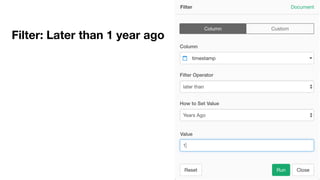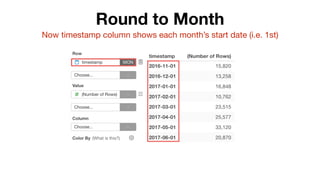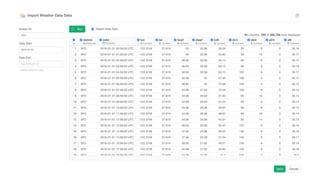Data Wrangling: Working with Date / Time Data and Visualizing It
- 1. EXPLORATORY
- 2. Kan Nishida co-founder/CEO Exploratory Summary Beginning of 2016, launched Exploratory, Inc. to make Data Science available for everyone. Prior to Exploratory, Kan was a director of development at Oracle leading development teams for building various Data Science products in areas including Machine Learning, BI, Data Visualization, Mobile Analytics, Big Data, etc. While at Oracle, Kan also provided training and consulting services to help organizations transform with data. @KanAugust Instructor
- 3. Mission Make Data Science available for everyone
- 4. Data Science is not just for Engineers and Statisticians. Exploratory makes it possible for Everyone to do Data Science. The Third Wave
- 5. First Wave Second Wave Third Wave Proprietary Open Source UI & Programming Programming 201620001976 Monetization Commoditization Democratization Statisticians Data Scientists Smart Waves - Machine Learning / AI Algorithms Experience Tools Open Source UI & Automation Business Users Theme Users Exploratory
- 6. Questions Data Science Workflow CommunicationData Access Data Wrangling Data Visualization Machine Learning / Statistics Exploration
- 7. Questions What you can do with Exploratory CommunicationData Access Data Wrangling Visualization Machine Learning / Statistics Exploratory Data Analysis
- 8. Questions CommunicationData Access Data Wrangling Visualization Exploratory Data Analysis Machine Learning / Statistics
- 9. Working with Date & Time
- 10. • User Activity Data • Each row represents an user access for a fictional online service. • There are 6 columns, timestamp, user id, event type, IP address, OS, and OS version. • Download EDF Data
- 12. Questions 1. What is the duration (date range) of this data? 2. What is DAU (Daily Active Users) and how it’s been changed over time? 3. Which days of week (e.g. Monday) and hours are more active?
- 15. Character vs. Date/Time Data Type
- 18. Character vs. Date/Time Date data is recognized as character. Dates duration is igonored Sorted as character. e.g. 10 (Oct.) comes after 1 (Jan) Data: Date-unicorn.csv
- 19. Character vs. Date/Time Various transformation on date data is available Data is sorted as dates. Duration honors date interval.
- 20. Date vs. POSIXct Data Type for Data & Time
- 21. Date POSIXct Only Date Both Date and Time
- 22. By making it to Date & Time data type, you can do a lot of cool things.
- 23. 1. Convert Character to Date / Time 2. Extract Date / Time Attributes 3. Filter with Date / Time 4. Duration 5. Round Date / Time 6. Timezone Common Tasks
- 24. 1. Convert Character to Date / Time 2. Extract Date / Time Attributes 3. Filter with Date / Time 4. Duration 5. Round Date / Time 6. Timezone Common Tasks
- 27. Only codes you need to know • Year • Month • Day • Hour • Minute • Second
- 28. Date Format 2017-01-01 y m d 2017-01-01 08:10:10 y m d h m s
- 29. ymd("2015-10-01") ymd("2015/10/01") ymd("Created on 2015 October 1st") ymd
- 30. ymd_hms("2015-01-10T06:10:15") ymd_hms("2015/01/10 06:10:15 UTC") ymd_hms("Created on 15-01-10 at 06:10:15 AM") ymd_hms
- 31. mdy("01-10-2015") mdy("01/10/2015") mdy("Created on 1 10 2015") mdy
- 32. mdy_hms("10-01-2015T06:10:15") mdy_hms("10/01/2015T06:10:15") mdy_hms("Created on 10 1 2015") mdy_hms
- 33. 1. Convert Character to Date / Time 2. Extract Date / Time Attributes 3. Filter with Date / Time 4. Duration 5. Round Date / Time 6. Timezone Common Tasks
- 35. • 2017-06-24 • June • 24th • 2017 • 175th day in 2017 • Saturday Date Attributes • 2017-06-24
- 36. • 2017-01-01 08:10:10 Time Attributes
- 37. • AM • 8 hours • 10 minutes • 10 seconds Time Attributes • 2017-01-01 08:10:10
- 38. month(start_time, label = TRUE) → Jan, Feb, Mar … Extract Month
- 39. Extract Month From Column Header Menu 1. Select “Extract” 2. Select “Month - Short Name (Jan)”
- 40. Extract Month
- 42. wday(start_time, label = TRUE) → Sun, Mon, Tue … Extract Day of Week
- 43. Extract Day of Week From Column Header Menu 1. Select “Extract” 2. Select “Day of Week - Short Name (Mon)”
- 44. Extract Day of Week
- 46. Ordinal - Ordered Factor • Month, Day of Week should be sorted in the natural order. • R’s factor data type supports ‘Order’ information. • Functions like ‘wday’, ‘month’, take care of it.
- 47. 1. Convert Character to Date / Time 2. Extract Date / Time Attributes 3. Filter with Date / Time 4. Duration 5. Round Date / Time 6. Timezone Common Tasks
- 49. Relative Date • Previous Year • This Year • Last <N> Years • Year to Date Year
- 50. Today20182017 Previous Year This Year 2016 Last 2 Years 2019 Year to Date Relative Date
- 51. Absolute Date • equal to / not equal to • is in / is not in • earlier than • later than • between
- 52. Today20182017 Year == 2017 Date > 1 year ago 2016 Year > 2016 2019 Between 2017-06-01 and 2018-1-30 Absolute Date
- 53. Filter: Year is 2017
- 54. Filter: Later than 1 year ago
- 55. Filter: Later than 2016-12-01
- 56. 1. Convert Character to Date / Time 2. Extract Date / Time Attributes 3. Filter with Date / Time 4. Duration 5. Round Date / Time 6. Timezone Common Tasks
- 57. 3 weeks 4 weeks 2 weeks First Date Last Date First Date Last Date First Date Last Date Duration
- 60. 1. Calculate lifetime for each user
- 61. 1. Calculate lifetime for each user
- 63. Duration is calculated and stored in ‘seconds’ (unit) as ‘difftime’ data type.
- 64. From Column Header Menu 1. Select “Change Data Type” 2. Select “Convert to Number” 3. Select “Days” 2. Convert the lifetime to numeric data type (in days)
- 65. 2. Convert the lifetime to numeric data type (in days)
- 66. as.numeric(duration, units = “days”) You can set ‘units’ inside ‘as.numeric’ function.
- 67. 1. Convert Character to Date / Time 2. Extract Date / Time Attributes 3. Filter with Date / Time 4. Duration 5. Round Date / Time 6. Timezone Common Tasks
- 68. Round Date/Time • Round • Ceiling • Floor
- 69. Round to Day
- 70. Round to Week Now timestamp column shows each week’s start date
- 71. Round to Month Now timestamp column shows each month’s start date (i.e. 1st)
- 72. # round round_date(start_time, unit="week") # ceil ceiling_date(start_time, unit="week") # floor floor_date(start_time, unit="week") Round vs. Ceiling vs. Floor
- 74. The border is on Wednesday noon Round
- 76. The border is on Sunday midnight (0:00am) Ceiling
- 78. The border is on Sunday midnight (0:00am) Floor
- 79. To round date to week.. From Column Header Menu 1. Select “Round” 2. Select “Round Date ” 3. Select “Week”
- 81. 1. Convert Character to Date / Time 2. Extract Date / Time Attributes 3. Filter with Date / Time 4. Duration 5. Round Date / Time 6. Timezone Common Tasks
- 82. • We have Temperature Data of London and Tokyo • Each row represents a temperature for a certain date/time in year 2016. There are 17,498 temperature data of London and 19,489 temperature data of Tokyo • Each temperature record has date/time, longitude, latitude, temperature, etc • Filename: Date-London-temp.csv and Date-Tokyo-temp.csv Timezone - Data
- 83. Extension Data - Weather
- 88. For London, 2:00pm is the peak of Average temperature → It sounds reasonable. For Tokyo, 5:00am is the peak of Average temperature → ??? When you compare hourly temperature data between London and Tokyo Data: Date-London-temp.csv, Date-Tokyo-temp.csv
- 89. • From the hourly temperature data of Tokyo, I want to know what time is the most hot in the day, but the time indicated by the date / time data is different from the actual time in Tokyo • We would like to compare average hourly temperatures of two cities with different time zones Problem
- 90. 2PM JST (Japan Standard Time) 2PM GMT (Greenwich Mean Time) Timezone
- 91. London Tokyo (Time difference from London: 9hours)
- 92. UTC (Coordinated Universal Time) • It is the base point for all other time zones in the world • POSIXct is basically based on the UTC • UTC and GMT (Greenwich Mean Time) are almost identical. (→ That is why the hourly temperature data for London is displayed correctly on the previous chart.)
- 93. Timezone • 2017-01-01 08:10:10 UTC • 2017-01-01 08:10:10 -900
- 94. Various Time zones • America/New York • America/Los_Angeles • Asia/Tokyo
- 96. with_tz # Append Timezone information with_tz(ymd_hms("2015-10-01 02:20:34”)) → "2015-09-30 19:20:34 PDT" Default value of with_tz is local machine’s timezone. In this example, PDT (Pacific Daylight Time)
- 97. with_tz(ymd_hms("2015-10-01 02:20:34”)) → "2015-09-30 19:20:34 PDT" with_tz(ymd_hms("2015-10-01 02:20:34"), tz = "Asia/Tokyo") → "2015-10-01 11:20:34 JST" with_tz By specifying timezone information, You can convert date/time to any timezone
- 98. with_tz From Column Header Menu 1. Select “Create Calculation”
- 99. with_tz
- 100. Credits
- 101. lubridate Do more with dates and times in R https://lubridate.tidyverse.org Garrett Grolemund Hadley Wickham Vitalie Spinu
- 102. Future Seminars
- 103. January 15th (Tuesday), 2019 • Data Wrangling: Working with Text Data Planned • Analytics 101 - When to use which algorithms? • Data Wrangling: Introduction to Regular Expression https://exploratory.io/online-seminar
- 104. Contact Email [email protected] Data Science Training https://exploratory.io/training Twitter @KanAugust Online Seminar https://exploratory.io/online-seminar














